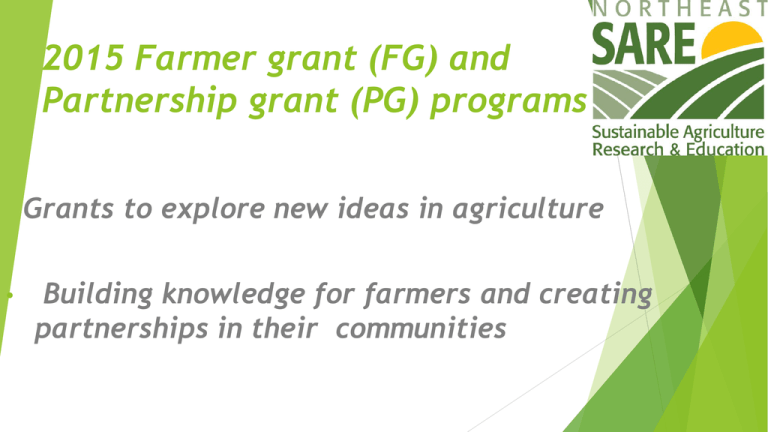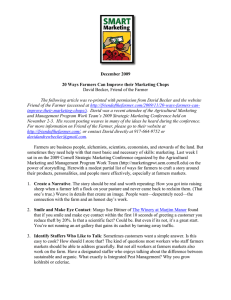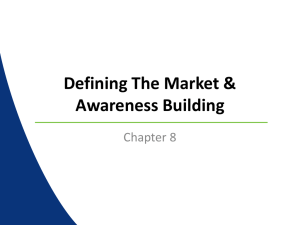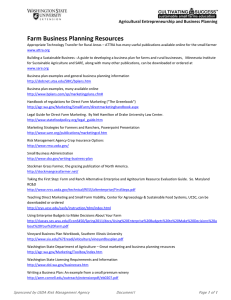2015 Farmer grant (FG) and Partnership grant (PG) programs
advertisement

2015 Farmer grant (FG) and Partnership grant (PG) programs Grants to explore new ideas in agriculture • Building knowledge for farmers and creating partnerships in their communities 2015 Northeast SARE Farmer and Partnership grant programs. 2 1 Underlying philosophy Overall opportunity Traits of a high quality application 3 Resources Goal is to share insight into the Farmer and Partnership grant programs. Objective: to allow individual to decide about applying Objective: to have participants get a good start on their proposal What is SARE? SARE = Sustainable Agriculture Research and Education Program USDA/NIFA competitive grants and outreach program Grants and education to advance innovations in sustainable agriculture. Northeast SARE serves Connecticut, Delaware, Maine, Maryland, Massachusetts, New Hampshire, New Jersey, New York, Pennsylvania, Rhode Island, Vermont, West Virginia, and Washington, D.C. Northeast SARE, University of Vermont 655 Spear Street Burlington, VT 05405 802-656-0471 nesare@uvm.edu www.nesare.org Northeast SARE Outcome Statement Agriculture in the Northeast will be diversified and profitable, providing healthful products to its customers; it will be conducted by farmers who manage resources wisely, who are satisfied with their lifestyles, and have a positive influence on their communities and the environment. 2014 NE-SARE Grants Portfolio Grant Type Total Number Submitted Total Number Approved Total Success rate Amount Funded Research & Education 28 9 31% $1,565,106 Professional Development 7 4 57% $484,712 Farmer 54 24 44% $221,850 Partnership 71 32 45% $321,562 Graduate Student 22 50 44% $312,994 Total $2,238,280 Mini-grants Farmer Grants For commercial farmers and farm managers who want to explore an interesting new idea. Partnership Grants For farm/community advisors who want to work with farmers on trials, demonstrations, networks and quality of life issues. Grants Are capped at $15,000. Run 1-2 years. What is a grant? Gift ● Receive $ ● don’t pay back ● no strings attached Loan ● Receive $ ● pay back ● strings? SARE Grant ● Receive $ ● don’t pay back ● strings attached Reimbursement for paid expenses Reporting and outreach required Northeast SARE’s definition of “What is a farm?” What is not… What is.. “…a commercial operation with an established farm income of at least a $1,000 from the regular sale of …” “Enterprises where the primary mission is education or research normally do not qualify as a farm…” Applies to both FG and PG Farmers listen to and learn from each other SARE believes that Farmers are inventive Farmers are observant Innovation is a continuum; grant topic at any stage Education Farms are gateways to new ideas Exploring solutions to infestations of Polydora sp. , Jesse Leach, Bagaduce Oyster Company, Maine Test a new crop Greenhouse ginger production, Melissa Bahret, Old Friends Farm, Massachusetts Protect the environment Evaluating no-till and biological striptill methods for commercial seedless watermelon production, Brian Hearns, Sandy Loam Farm, Delaware Farmers are leaders and teachers A Vermont farmers breeding club, Jack Lazor, Vermont Farms are laboratories Time to grow crops vs. day of year planted, part II, Steve Fulton, Blue Ox Farm, New Hampshire Test a product Mas-D-Tec mastitis tool for dairy goats, Liz Mulholland, Valley View Farm, Massachusetts Product testing and development must have benefits to wider community* Product testing: Product Development: share design or ‘recipe’ share results Examples Test a new cloud-based data system for farm management through feasibility studies to identify possible improvements Combine beneficiary insects with a commercial drench to control root aphids in Christmas trees Examples Design and build an ATV attached hay carrier Design and build a sensor system for frost alerts on a vegetable farm Software development is available Open source (github) and licensed -opensource.org/licences No sharing of design/recipe Not eligible for SARE funding * Products should be safe and meet applicable legal codes and restrictions How to apply: Follow the “get a grant” option at www.nesare.org. Read website content and download application instructions. Write proposal and develop budget. Submit online by copying from your document and uploading files. Wait for results by March 1, 2015. 2015 Timeline Deadlines: PG: November 4, 2014 23:59:59 FG: December 2, 2014 23:59:59 Review period: November If 2014 – February 2015 disqualified, will find out within a week of deadline Award announced by email by early March 2015 Contracts by April/May 2015 Comments to non-awarded applicants May 2015 Farmer grant Best ones are funded Subtitle: Grants to explore new ideas in agriculture. Required uploads Technical advisor provides letter Check box online confirming they have a commercial farm Budget justification template (Image of prototype) One application per farm Farmers can ask for up to $1,000 for specialized equipment if it is necessary for the project; it is more favorable if the applicant shares the cost; Farmer grant questions 1. What is the problem and why is it important? 500 words 2. What is your proposed solution? 200 words 3. What efforts have been made to solve the problem? 4. What will your methods and measurements be? 5. What is the timetable of your project? 500 words 6. What is the outreach plan? 250 words 7. What is your farm business and how will your project fit in with your farm operation? 300 words 8. Budget justification and narrative. Refine your approach Partnership grant Best ones are funded Farmers are target audience Research on one commercial farm or involves one farmer Letter from farmer One application per applicant Organization may have multiple applicants for different projects Budget justification template Indirect is allowed if the institution has a negotiated indirect rate with the federal government No limit on equipment reimbursement request Subcontracting of >50% disallowed Sign-off sheet from institution due at deadline 2015 Partnership grant Commitment to community projects Subtitle: Building knowledge for farmers and creating partnership in their communities Community project topics merged in 2014. 21 of 71 applications had social benefit subject and 11 were approved for funding – 52% success rate 2015 Partnership grant questions 1. What is the problem and why is it important? 350 words 2. What is your proposed solution? 200 words 3. How does your project build on what has been done done before? 450 words 4. What are your project methods? 1000 words 5. What is the project timetable? 500 words 6. How will you disseminate your project results? 300 words 7. What are your qualifications? 500 words 8. Who are the project’s cooperating farmers and key collaborators? 500 words 2. What is your proposed solution? “The goal of this study is to answer whether peanut hulls are an equal substitute for straw as bedding for sheep. In this project, we will compare the use of peanut hulls verses straw as bedding for sheep in the winter in terms of cost, absorption, ease of handling and, sheep health. Our objective is that this information could help lower costs and increase sheep health on sheep farms.” Or “ We want to find out if peanut hulls a good substitute for winter bedding for sheep as related to cost, absorption, ease of handling and, sheep health. Our objectives are to help lower costs and labor for sheep farmers and increase health of sheep. We hope to do this by finding an alternate or better choice than straw for bedding. “ Report Methods and budget Proposed solution Suzy Konecky, Cricket Creek Farm, Williamstown, MA FNE14-805, Evaluating the efficacy of multiple foliar sprays for soil health, pasture quality, and cow productivity Easy to summarize: Succinct, effective “Our goal is to collect clear data on the efficacy and cost effectiveness of foliar treatments that will allow farmers to make informed decisions, and thus mitigate much of the risk of undertaking a foliar spray program.” “We are interested in studying the effectiveness of invasive Eurasian Milfoil(EM) as an organic soil amendment because its removal improves water quality and is essential to aquatic environmental stewardship in our area. At the same time, its application may improve soil health on small farms in our region by adding valuable organic matter to the soil and possibly delivering important nutrients.” He l p o t h e r f a r m e r s Su s t a i n a b i l i t y l i n k s “This project aims to test the sowing of brassicas into small grains to potentially add an economically and environmentally sustainable crop for dairy farmers in the Northeast.” He l p o t h e r f a r m e r s Su s t a i n a b i l i t y l i n k s What makes a high quality application? Convincing – affects other farmers and applicant has experience What do other farmers and experts in the field say? Area where information is lacking Do the research; not just SARE projects Be up to date with current information Strong farmer – Advisor/PI connection Easy to summarize proposal Convincing: Issue Grantees convince reviewers that this issue is significant regionally and locally. “Spotted wing Drosophila (SWD) was found in NYS in the fall of 2011 and caused an estimated $3 million loss in berry crops in NYS in 2012. I had a 40% loss in my blueberries in 2012” “A study in 2007-2008 by VanEngelsdrop, Tarpy, Lengerich, and Pettis followed 20, 24, and 18 colonies in three different operations for a total of 62…at the end of the 10 month period 56% (35 out of 62) had died out…Many studies have been done over the years that have shown Nosema Apis to be a large problem with overwintered colonies …I visited a fellow beekeeper in early Sept. 2012 that used to manage 1200 hives and he told me … he had lost 80% of his colonies.” Information is lacking/Novel idea “Poultry production in the NE depends on a fossil-fuel saturated supply chain of feed from other regions of the US. Because geese, unlike other commonly raised avians, can derive much of their nutrition from pasture and forage, goose farming may be able to produce sustainable, highquality poultry with a good economic return. However, there is little research about feeding geese in New England with limited grain.” Clear objectives and goals (PG example) o u t co m e “The objective of this NESARE Partnership Project is to expand the BFN/Mass Network by strengthening partnerships among farmers, agricultural service providers, and community organizations to identify gaps, develop new programming, and expand utilization of services for new farmers….Project goals are to: expand farmer access to and use of programs and services to improved productivity, their economic bottom line, and quality of life;….” su st a in a b ilit y Methods: include exact tests This proposal will concentrate on three areas to improved the knowledge and education of implementing a sprouted grain system on dairy farms in the Northeast over a 12 month period: 1. Nutritional value of sprouted grains –wet chemistry; list 2. Animal production – milk yield and composition, herd and individual milk tests – component list 3. Implementation and economics – milk income, price per pound Th e “ Wh a t ” w it h det ail Budget: Use grant funds for … Budget summary matches Budget justification excel template Personnel Non-Personnel Other Direct Costs PG eligible for Indirect costs Resources at www.nesare.org NE-SARE Website – videos of Farmers and their TAs, PPTs, What is a farm/topic definitions, Sample grants Summer 2014 Newsletter Innovations Contact state coordinator, www.nesare.org – Mentor list How to write a SARE Farmer grant – guidance; read for content Resources: How to write a SARE Farmer grant Questions? Carol Delaney 802/656-0697 Carol.Delaney@uvm.edu www.nesare.org




